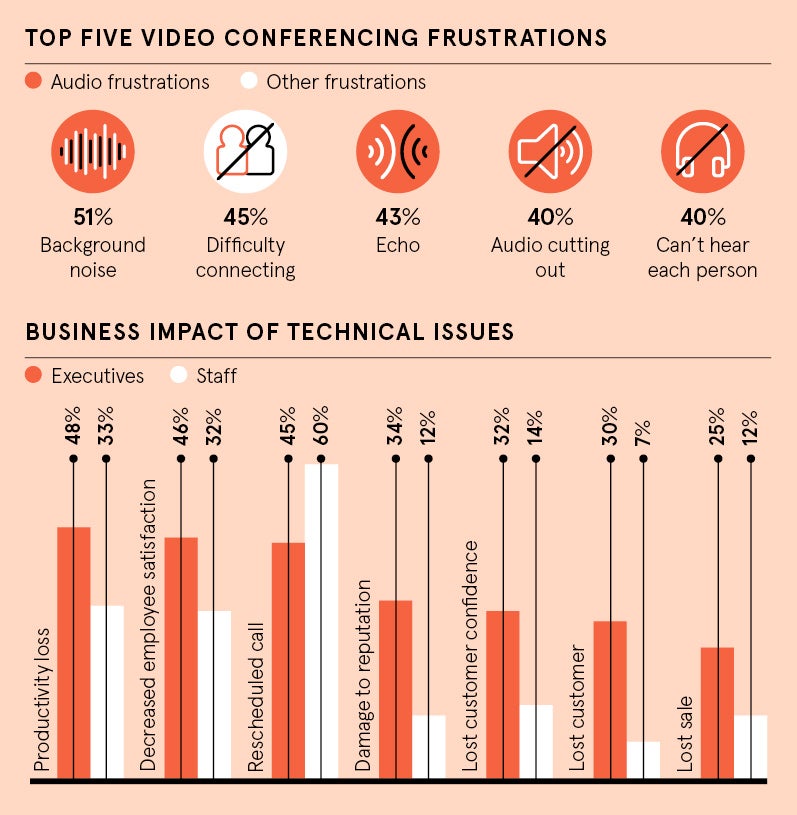The world’s remote workforce has grown enormously in recent years, fuelled by globalisation and the proliferation of cloud-based IT solutions. Nearly a quarter of Britain’s employees now work flexibly across different locations, according to Lloyds Bank. This figure continues to rise as companies embrace benefits, which include cost-savings, greater agility, higher staff satisfaction and enhanced information-sharing across locations, not to mention connecting with previously hard-to-reach customers.
The increasingly dispersed workforce has accelerated use of virtual collaboration tools as an alternative to face-to-face meetings, with employees now using an average of five different tools to do their jobs. Seven in ten meetings are already virtual and nine out of ten employees say they’re imperative to the success of their organisation, according to a survey by Illuminas, commissioned by Shure Incorporated.

In a business landscape currently affected by the need for staff to work from home, virtual meetings become even more important; vital, in fact, to business continuity.
However, the same study found that 96 per cent of professionals are frustrated with their virtual meetings and four out of their five main frustrations relate to audio: background noise, echo, sound cutting out and not being able to hear the other meeting participants. As a result of technical issues, 82 per cent said they have experienced negative consequences, including rescheduled calls, damage to brand reputation or loss of customer trust.
These technical issues are happening so frequently that four in ten employees are escalating them on a weekly, if not daily, basis, regularly requiring the time and assistance of more than half of IT professionals. Executives are twice as likely to worry about the consequences, with more than 40 per cent of them feeling personal disappointment and embarrassment, which means they report experiencing technical issues even more.
According to the research, poor audio quality affects a third of virtual meetings. Flawless audio quality is four times more important than video to meeting attendees.
It’s time to put an end to poor audio quality
“Audio is often the most overlooked element of a successful virtual meeting because typically you don’t get the feedback, know how you sound from the other side or have a good perception of how that conversation is going,” says Rob Smith, senior director at Shure Incorporated, which has more than 90 years’ experience developing best-in-class audio products that provide high-quality and seamless performance and reliability.
Shure’s diverse product line includes wired and wireless microphones, networked audio systems and signal processors, conferencing and discussion systems, earphones and headphones.
“Many people just accept that poor audio quality in video conferencing is the way things are, but the reality is there are far better options out there,” says Smith. “When installing video conferencing systems, companies need to ensure audio is thoroughly thought through and part of the overall solution. By investing in technology from the likes of Shure, you can enable an almost face-to-face experience for your remote workforce and customers. User behaviour should drive technology, not the other way around.
“Video conferencing is most effective when it’s frictionless. It just works. That’s what we enable with our world-class audio products. It’s time to put an end to poor audio quality.”
As organisations increasingly look to embrace smart technologies and innovations such as artificial intelligence and machine-learning in their collaboration strategies, it’s crucial they are first able to achieve a flawless audio experience.
Shure advises companies to provide training for users on existing tools so they can use them more effectively, and to embrace technology and equipment that make it a user-friendly environment. The future of business will no doubt be dominated by virtual meetings, but laying the foundations must start with prioritising investment in the area that will make the biggest difference to productivity: consistent, seamless and quality audio.
To download the full Illuminas/Shure report please visit everyvoice.shure.com





